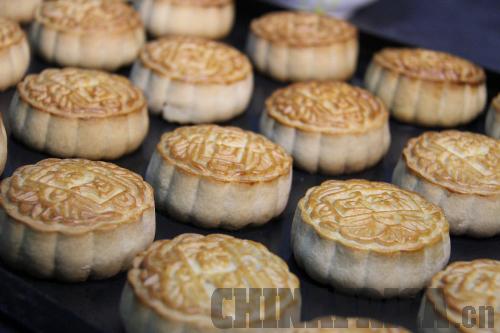|
 |
|
Mooncakes XINHUA |
When it comes to expressing adoration for a loved one, doing it under the light of a full moon is guaranteed to score mega romantic points. In China, at Mid-Autumn Festival the moon is the guest of honor and along with a connection of hearts comes a nation's insatiable desire for moon cakes.
Second in importance only to the Chinese New Year, Mid-Autumn Festival, also known as Moon Festival, has as its focus the reunion of families and loved ones. As an officially sanctioned one-day holiday, it has therefore developed over time into a gathering of family members living in the same city – and for those split by distance, it's become a lunar connection.
Traditionally a time to celebrate the end of the harvest season, it's also a time to renew old friendships and make new friends, and given the moon's universal mystical appeal this is a perfect setting for romantic encounters. Over the years Chinese poets have written sonnets about long separated lovers making their way back to each other on this special night and every family has a tale to tell of a starry eyed proposal brought on by the lunar light.
The festival falls on the 15th day of the eighth lunar month, which makes it September 12 this year.
Along with the family connection the festival is characterized by the famous Chinese moon cake. It is said to have originated during the Yuan Dynasty (1279-1368) in the 14th century, when people planned a rebellion at Moon Festival by smuggling details of their attack inside specially baked cakes – the resulting battle led to the overthrowing of the government and the eventual formation of the Ming Dynasty (1368-1644) that ruled imperiously for the next around 250 years.
The sight of the moon cake invasion in China is something to behold. This is the only time of the year you'll see this confectionary and wherever you are in China you'll be bombarded by adverts, jingles and banners all proclaiming the delectable attributes of the moon cake phenomenon. It's as if every supermarket shelf, vendors' stand and restaurant serving trolley is loaded with endless shiny brown moon cakes and the whole world has gone moony.
And moon cakes don't just come in a plastic wrapper or brown paper bag. These lunar treats are packaged in some of the most elaborate and colorful boxes and wrappings you've ever seen. The Chinese are certainly no slouches when it comes to marketing their moon cakes, especially the famous quality brands such as Daoxiangcun, Dasanyuan and Fangshan, all preferred when offering the cakes as gifts to colleagues and friends.
Liking nothing more than variety in anything they eat, Chinese moon cakes come in several lip-smacking flavors. Traditionally made of lotus seed paste, peanut oil and glutinous rice flour, all encased in pastry, pressed into a patterned tray (usually bearing the log of the baker) and removed from the oven as golden brown moon cakes, the lotus paste can also contain salted egg yolks, red bean paste (now rapidly replacing the very expensive lotus seed paste) assorted nuts, fruit and ham bits. As it takes two to four weeks to prepare the seed paste and the whole process is so labor intensive, most families just buy them from bakeries.
Modern moon cakes are even now made of a chocolate crust with ice cream filling, while the more exotic varieties include cream cheese and raisins, ginseng and bird's nest and lotus and green tea moon cakes.
The Moon Festival is also known as the Women's Festival, because of the moon, or "yin" being the feminine principle and the Chinese character for moon representing beauty and elegance. This has led many Chinese parents to name their daughters after the moon (yue) in anticipation that their one and only will grow up bright, benevolent and beautiful.
As with all aspects of culture and tradition, the technological age has made inroads into the custom of giving moon cakes to clients and friends. This year newspapers reported growing numbers of people sending goodwill messages and electronic images of moon cakes via microblogs and phone text messages.
For foreigners living in China, eating moon cakes and gazing at the moon, said by Chinese legend to be at its roundest and brightest on the Mid-Autumn Festival, is a way to get caught up in the moment of romance. If you don't have your special "other" with you, at least you have the comforting company of the moon cakes. After all, no-one should be alone under a harvest moon. |